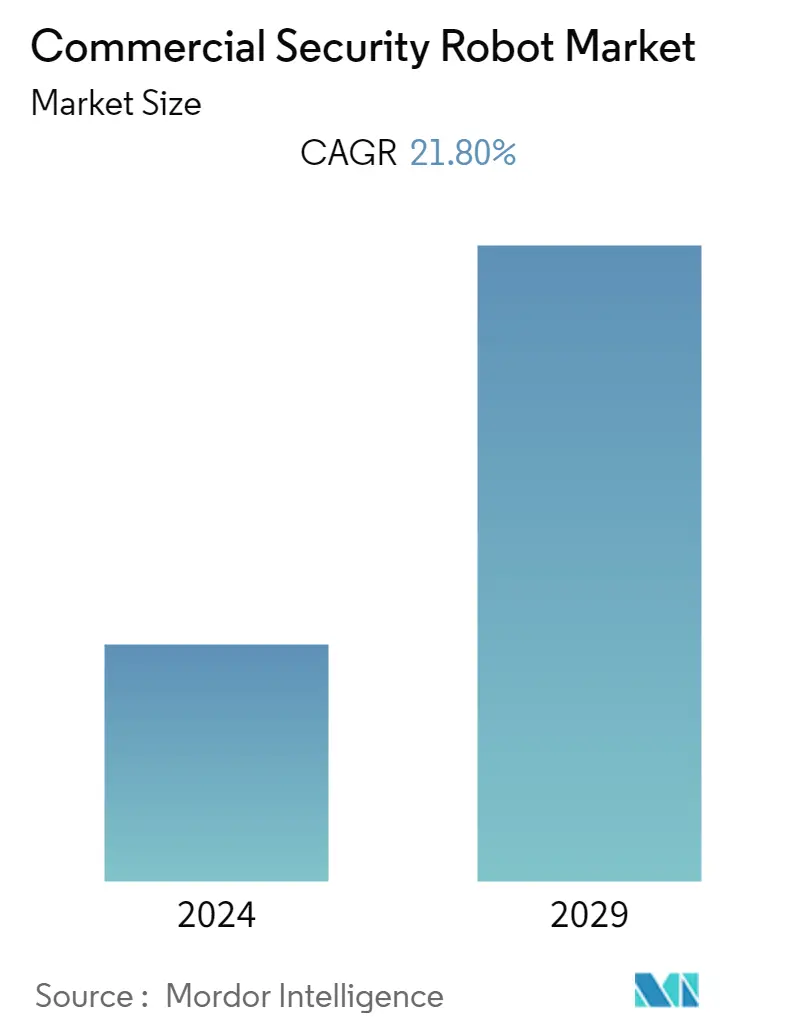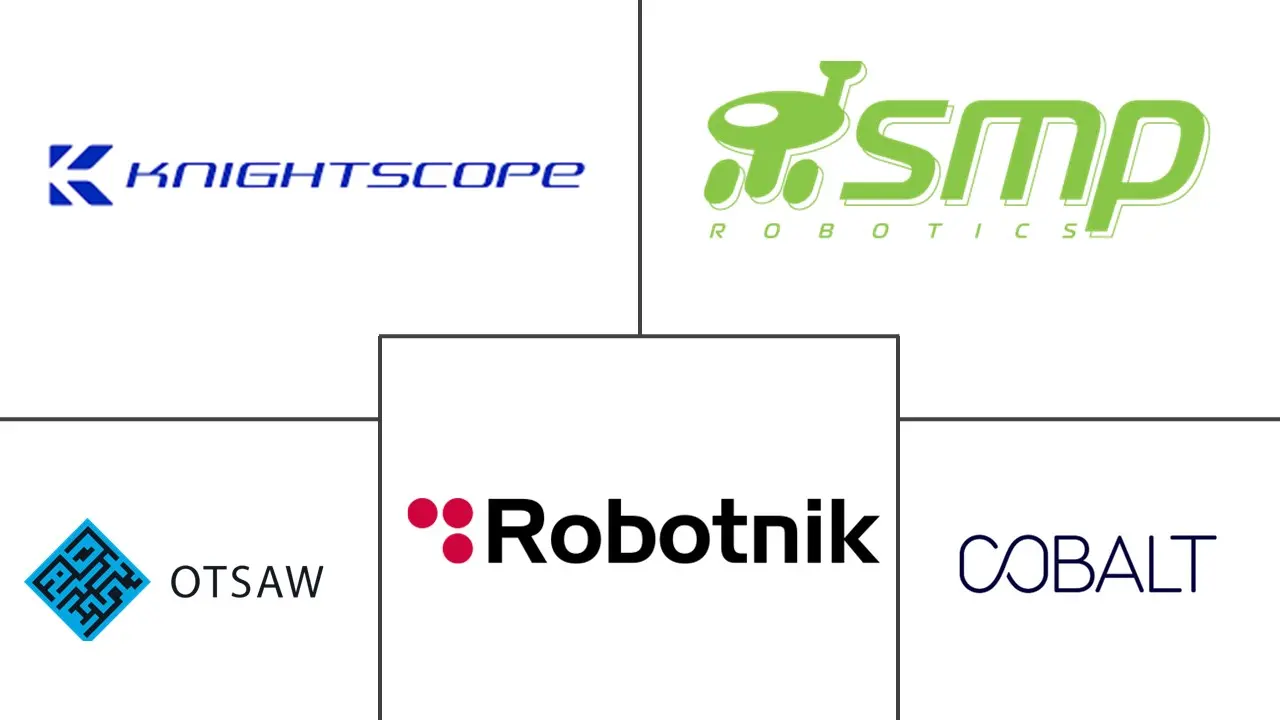Market Size of Commercial Security Robot Industry

| Study Period | 2019 - 2029 |
| Base Year For Estimation | 2023 |
| CAGR | 21.80 % |
| Fastest Growing Market | North America |
| Largest Market | North America |
| Market Concentration | Low |
Major Players
*Disclaimer: Major Players sorted in no particular order |
Commercial Security Robot Market Analysis
The commercial security robot market was valued at USD 557.82 million the previous year. It is expected to reach USD 1.67 billion by 2028, registering a CAGR of 21.8% over the forecast period. Commercial security robots are designed to replace patrolling security guards and provide mobile CCTV monitoring. A security robot automatically moves around a restricted area without direct operator supervision. Images from the built-in cameras are transmitted to the security station. These robots help security personnel detect probable threats, take a close look from a safe distance, and provide comprehensive information about the threat to take preventive measures.
- Security robots can perform a wide range of functions in and around the commercial sector in addition to patrolling duties. Many robots can now be equipped with various sensors, including ultrasonic and LiDAR ones, as the Internet of Things (IoT) develops and advances. This allows them to identify more anomalies, particularly in risky circumstances. These sensors make it possible for them to do more than just prevent crime.
- Advancements in robotics, artificial intelligence, and sensor technology have made commercial security robots more sophisticated and capable of performing complex tasks such as autonomous patrolling, surveillance, and real-time data analysis. The rapid development of artificial intelligence has enabled robots to have higher intelligence. They can now replace humans in undertaking many important tasks.
- According to Zippia, the average age of a security guard in the United States is 43 years. According to the Australian government's data, a security guard's average age is 41 years. As a result, the security industry is unstable and demands more technologically advanced solutions. Moreover, police departments often face challenges due to limited resources, including workforce shortages. The current availability of police officers is insufficient to cover all security needs and ensure comprehensive surveillance in every area, creating a need for commercial security robots.
- The high installation cost of security robots is a significant factor that may hinder some organizations from adopting this technology. Security robots often incorporate cutting-edge technologies such as AI, sensors, autonomous navigation, and communication systems, which can be expensive to develop and implement. Moreover, automation equipment manufacturing requires high capital expenditure in automation technologies because an automated system can cost millions of dollars to design, fabricate, and install.
- The COVID-19 pandemic has expanded the scope of the commercial security robot market as the risk of infection of security personnel rose significantly during the initial days of the pandemic. The spread of infection from one person to another often led to the need to hire new employees or reduce the quality of service and safety. This prompted the adoption of commercial security robots.
Commercial Security Robot Industry Segmentation
Commercial security robots are autonomous robots designed to enhance security measures in various commercial settings. They are equipped with advanced sensors, cameras, and artificial intelligence capabilities to perform tasks such as surveillance, patrolling, and monitoring specific areas.
The market size for commercial security robots is evaluated by analyzing various end users, such as government institutions, commercial spaces, research & development centers, and industrial setups. The competitive landscape includes the penetration of commercial security robots and how market players involve themselves in organic and inorganic growth strategies. These companies continuously innovate their products to increase their market share and profitability. The market size is provided in terms of value in USD for all the abovementioned segments.
Commercial Security Robot Market Size Summary
The commercial security robot market is experiencing significant growth, driven by advancements in robotics, artificial intelligence, and sensor technology. These robots are designed to enhance security measures by replacing traditional patrolling guards and providing mobile CCTV monitoring. They operate autonomously within restricted areas, transmitting real-time data and images to security stations, which aids in threat detection and prevention. The integration of IoT-enabled sensors, such as ultrasonic and LiDAR, has further enhanced their capabilities, allowing them to identify anomalies and perform complex tasks like autonomous patrolling and real-time data analysis. This technological evolution is addressing the challenges posed by an aging security workforce and resource constraints in law enforcement, thereby increasing the demand for automated security solutions.
The market is characterized by a competitive landscape with numerous global and regional players, including Knightscope, SMP Robotics, and Cobalt Robotics, who are leveraging established distribution networks to maintain their market positions. The high installation costs of these advanced systems pose a barrier to widespread adoption, yet the benefits of enhanced security and operational efficiency are driving their integration into commercial settings. The COVID-19 pandemic has also accelerated the adoption of security robots, as they reduce the risk of infection among human personnel. As the need for robust security solutions grows, particularly in response to rising crime rates, the market for commercial security robots is poised for continued expansion, with significant opportunities in various sectors such as healthcare, retail, and public safety.
Commercial Security Robot Market Size - Table of Contents
-
1. MARKET INSIGHTS
-
1.1 Market Overview
-
1.2 Industry Attractiveness - Porter's Five Forces Analysis
-
1.2.1 Bargaining Power of Suppliers
-
1.2.2 Bargaining Power of Buyers/Consumers
-
1.2.3 Threat of New Entrants
-
1.2.4 Threat of Substitutes
-
1.2.5 Intensity of Competitive Rivalry
-
-
1.3 Industry Value Chain Analysis
-
1.4 Technology Snapshot
-
Commercial Security Robot Market Size FAQs
What is the current Commercial Security Robot Market size?
The Commercial Security Robot Market is projected to register a CAGR of 21.80% during the forecast period (2024-2029)
Who are the key players in Commercial Security Robot Market?
Knightscope, Inc. , SMP Robotics Systems Corp. , Cobalt Robotics, OTSAW Digital Pte Ltd and Robotnik Automation SL (United Robotics Group Gmbh) are the major companies operating in the Commercial Security Robot Market.

